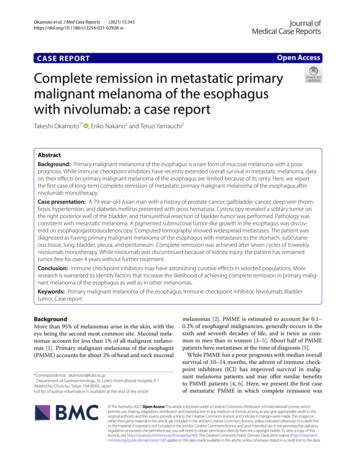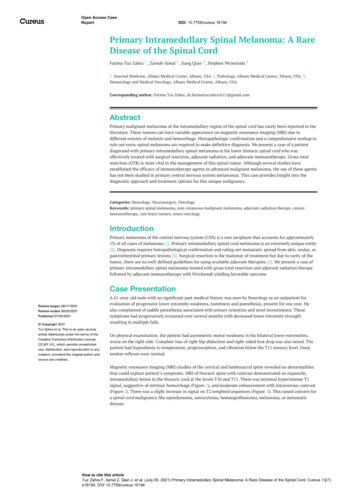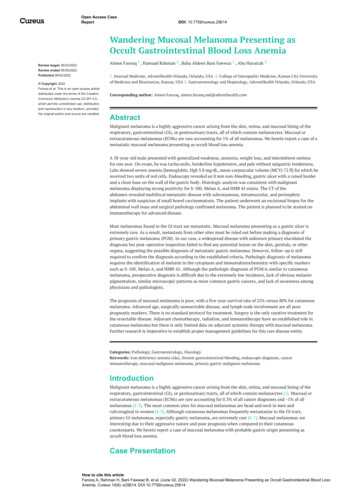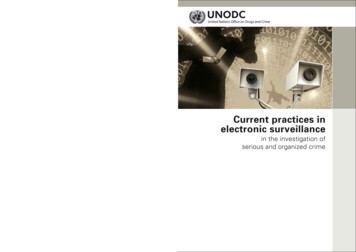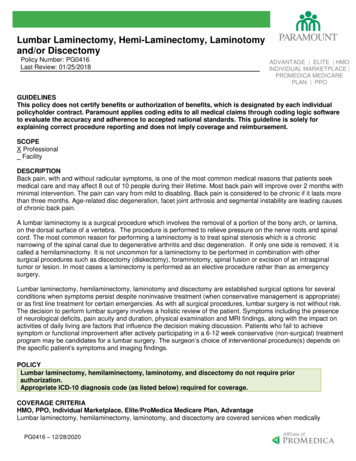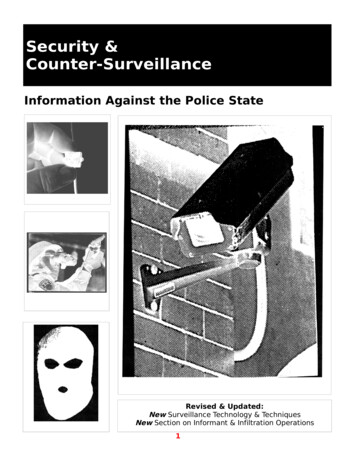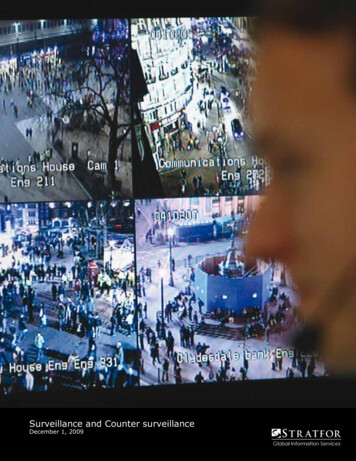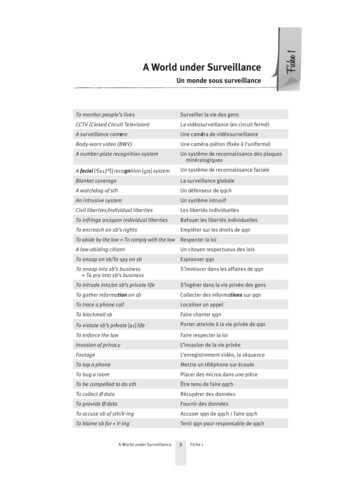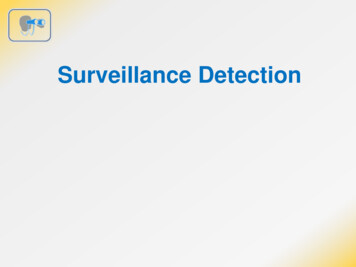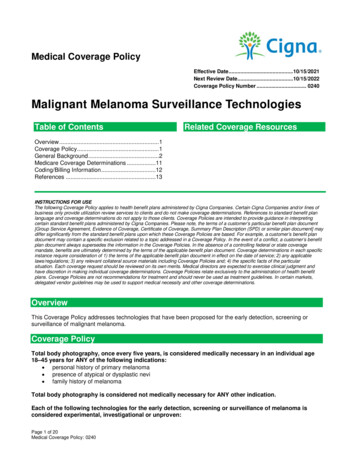
Transcription
Medical Coverage PolicyEffective Date .10/15/2021Next Review Date.10/15/2022Coverage Policy Number . 0240Malignant Melanoma Surveillance TechnologiesTable of ContentsRelated Coverage ResourcesOverview . 1Coverage Policy.1General Background .2Medicare Coverage Determinations .11Coding/Billing Information .12References .13INSTRUCTIONS FOR USEThe following Coverage Policy applies to health benefit plans administered by Cigna Companies. Certain Cigna Companies and/or lines ofbusiness only provide utilization review services to clients and do not make coverage determinations. References to standard benefit planlanguage and coverage determinations do not apply to those clients. Coverage Policies are intended to provide guidance in interpretingcertain standard benefit plans administered by Cigna Companies. Please note, the terms of a customer’s particular benefit plan document[Group Service Agreement, Evidence of Coverage, Certificate of Coverage, Summary Plan Description (SPD) or similar plan document] maydiffer significantly from the standard benefit plans upon which these Coverage Policies are based. For example, a customer’s benefit plandocument may contain a specific exclusion related to a topic addressed in a Coverage Policy. In the event of a conflict, a customer’s benefitplan document always supersedes the information in the Coverage Policies. In the absence of a controlling federal or state coveragemandate, benefits are ultimately determined by the terms of the applicable benefit plan document. Coverage determinations in each specificinstance require consideration of 1) the terms of the applicable benefit plan document in effect on the date of service; 2) any applicablelaws/regulations; 3) any relevant collateral source materials including Coverage Policies and; 4) the specific facts of the particularsituation. Each coverage request should be reviewed on its own merits. Medical directors are expected to exercise clinical judgment andhave discretion in making individual coverage determinations. Coverage Policies relate exclusively to the administration of health benefitplans. Coverage Policies are not recommendations for treatment and should never be used as treatment guidelines. In certain markets,delegated vendor guidelines may be used to support medical necessity and other coverage determinations.OverviewThis Coverage Policy addresses technologies that have been proposed for the early detection, screening orsurveillance of malignant melanoma.Coverage PolicyTotal body photography, once every five years, is considered medically necessary in an individual age18–45 years for ANY of the following indications: personal history of primary melanoma presence of atypical or dysplastic nevi family history of melanomaTotal body photography is considered not medically necessary for ANY other indication.Each of the following technologies for the early detection, screening or surveillance of melanoma isconsidered experimental, investigational or unproven:Page 1 of 20Medical Coverage Policy: 0240
visual image analysiselectrical impedance devicesmultispectral image analysisultrasoundoptical coherence tomography [OCT]reflectance confocal microscopy [RCM]multiphoton microscopyRaman spectroscopy3D imageryphotoacoustic microscopy3D color histogram mappingstepwise two-photon-laser spectroscopyquantitative infrared imagingmultiphoton tomographythermal imagingmolecular fluorescent imagingDermoscopy is considered to be an integral part of a normal evaluation of a pigmented skin lesion andnot separately reimbursable.General BackgroundMelanoma, also called cutaneous melanoma or malignant melanoma, is a malignant disease of the skin and oneof the most dangerous forms of skin cancer. Although melanoma accounts for less than 5% of skin cancercases, it accounts for approximately three-fourths of all skin cancer deaths. Early detection and treatment are thebest strategies to reduce the mortality and morbidity associated with melanoma. Only 20 to 30 percent ofmelanomas are found in existing moles, while 70 to 80 percent arise on normal skin with no associated nevus(Cymerman, 2016). Moles are common with the average person having 10–40. Puberty is a time when the sizeand number of nevi increase with very few moles developing after the age of 40 (Hooper and Goldman, 1999).Risk factors for the development of single or multiple primary melanomas include male sex, age 60 years,phenotypic predisposition, personal medical history/comorbidities and environmental factors (NationalComprehensive Cancer Network [NCCN], 2021; National Cancer Institute [NCI], 2021). High-risk individuals formelanoma include those with a personal history of prior primary melanoma, presence of pigmented lesions (e.g.,atypical nevi, dysplastic nevi) or a first-(i.e. parent, sibling or child) or second-degree relative with melanoma(NCCN, 2021; NCI, 2021; Goodson, et al., 2010; Banky, et al., 2005; Oliveria, et al., 2004; Haenssle, et al.,2004). There are certain characteristics that place patients at higher risk of dying from melanoma. Despite therebeing a lower incidence of melanoma in Black patients, the five-year relative survival is lower than for whitepatients (69% vs. 93%) (Geller and Swetter, 2021; Cormier, et al., 2006). This trend has been observed in theHispanic American population and is thought to be due to a greater likelihood of presenting with advanceddisease compared to non-Hispanic white individuals (Cockburn, et al., 2006). The greater mortality in patientswith skin of color may be due to several factors including delayed diagnosis due to a lower perceived risk ofdisease or lower rates of skin examinations, locations of melanoma in atypical non-sun-exposed areas (eg, leg,hip, and feet), a higher proportion of acral and nodular subtypes, and a decreased ability to seek care forlocalized disease (Carter, et al., 2021; Coups, et al., 2012; Myles, et al., 2012; Pollitt, et al., 2011). Almost 50percent of melanoma deaths in the United States occur in white men over the age of 50 (Geller and Swetter,2021). The poor survival rate in men may be due to differences in tumor biology and by differences in skinawareness, self-examination, and other early detection practices.The assessment of suspicious skin lesions begins with a physical examination and visual inspection of the skinwith the naked eye. Dermoscopy including digital epiluminescence microscopy (DELM) has evolved into anestablished technology used as an adjunct to a normal eye exam and is considered to be an integral part of theexam depending on the lesions being examined. Additional noninvasive technologies are proposed to providebetter examination of lesions and assist the examiner in deciding whether a lesion should be biopsied. None ofthese devices can diagnosis skin cancer. Biopsy is considered the diagnostic “gold standard”. NoninvasivePage 2 of 20Medical Coverage Policy: 0240
technologies include: total-body photography (TBP); visual image analysis; electrical impedance devices;multispectral image analysis; ultrasound, optical coherence tomography [OCT]; and reflectance confocalmicroscopy (RCM). There is insufficient evidence in the peer-reviewed literature to support the use of thesenoninvasive technologies for the evaluation and surveillance of melanoma.Total Body Photography (TBP)TBP, also known as whole body photography, surveillance photography, total body mapping, has been proposedfor screening and monitoring for the early detection of skin cancers, especially for people at high risk formelanoma. A proposed disadvantage of TBP is the poor resolution of images and loss of follow-up innoncompliant patients. The majority of melanomas are pigmented, but 2–8% are hypopigmented and detectionby a TBP imaging system may be less reliable than with pigmented lesions. Historically, TBP has beenperformed via 2D imaging and is now evolving into 3D capabilities. The intent is that 3D imaging will improvediagnostic accuracy, be time and cost efficient and more accessible to patients. TBP involves a series of multiplephotographs (25–40) of head-to-toe images of the patient’s entire cutaneous (skin) surface and is proposed forhigh-risk patients with multiple lesions. The photographs may be enlarged to show the details of lesions. Newphotographs can be compared with previous photographs to determine if a lesion has changed. Photographs aregenerally useful for 5–8 years. Available software can automatically match lesions on two standardizedphotographs and highlight new or changed lesions. Examples of this software are the Fotofinder bodystudioLITE (FotoFinder Systems Inc. Columbia, MD) and MIRROR Body Mapping Module (Digitale PhotographieGmbh, Fairfield, NJ). (Rayner, et al., 2018; Mayer, et al., 2014; Guitera and Menzies, 2011). Total bodyphotography has evolved into an accepted surveillance technique for individuals with an increased risk ofsubsequent primary melanomas, such as prior multiple primary melanomas, family history of melanoma, and thepresence of atypical/dysplastic nevi (NCCN, 2021).US Food and Drug Administration (FDA): Because the cameras used for surveillance are not consideredmedical devices, they are not regulated by the FDA.Literature Review: Watts et al. (2015) conducted a systematic review of published international clinical practiceguidelines for the identification, screening and follow-up of individuals at high risk for primary cutaneousmelanoma. Thirty-four guidelines from 20 countries were included. Consistently reported high-risk characteristicsincluded: many melanocytic nevi, dysplastic nevi, family history, large congenital nevi, and Fitzpatrick Type I andII skin types. Monitoring of high risk individuals was recommended but only half of the guidelines recommendedscreening based on level of risk. There were high levels of evidence for targeted, regular monitoring usingdermoscopy and sequential digital dermoscopy imaging (SDDI) but low levels of evidence for the use of totalbody photography (TBP).Salerni et al. (2011) reported surveillance of 618 patients at high risk for melanoma using digital total bodyphotography and digital dermatoscopy. A total of 11,396 lesions were monitored (mean 18.44/patient) during amedian follow-up of 96 months (median 10 visits/patient).Data analysis revealed that older age at inclusion andhigher number of lesions excised during follow-up were the variables most associated with melanoma diagnosisduring surveillance (p 0.003 and p 0.001, respectively). A total of 98 melanomas (8.5% of excised lesions) werediagnosed in 78 patients (12.6%). No conclusions regarding the impact of TBP on long-term health outcomescan be drawn from this study as there were no control groups.In a prospective trial, Goodson et al. (2010) sought to determine whether biopsy rate, rate of melanomadetection, and melanoma derivation (nevus derived versus de novo) differed, using total body and digitalepiluminescence microscopy (DELM) photography. A total of 889 new patients and 187 established patientswere included. Most patients had one or more of the following melanoma risk factors: three or more clinicallyatypical nevi, more than 50 nevi, personal history of melanoma, and two or more family members with history ofmelanoma. Follow-ups occurred for 6-12 months. A total of 110 patients were lost to follow-up. The patientsunderwent total body photography and were monitored using photographs obtained at the initial visit. Riskfactors and median monitoring periods for these patients were comparable with those of patients previouslymonitored using DELM photography. A total of 275 biopsies were performed on 467 patients on follow-up visits.The authors cited low biopsy rates on follow-up visits with both approaches (0.59 biopsies per patient with totalbody photography versus 1.1 per patient with DELM photography, statistically significant). The significantlyhigher biopsy rate with DELM photography may be a consequence of the greater sensitivity for detectingPage 3 of 20Medical Coverage Policy: 0240
morphologic changes in nevi because of higher resolution of these photographs and the fact that lesionsexhibiting photographic change were more likely to be biopsied.Banky et al. (2005) conducted a prospective case series (n 309) to assess the effectiveness of total bodyphotography and dermoscopy in the evaluation of new, changed and regressed nevi and melanomas. Includedpatients were referred to a dermatologist for clinical examination and had at least one of the following risk factorsfor melanoma: four or more clinically dysplastic nevi, 100 or more melanocytic nevi, a personal history ofmelanoma, or a family history of melanoma. Individuals with one of these risk factors underwent total bodyphotography. Biopsy specimens were not obtained of all changed and new pigmented lesions. If melanomacould not be confidently excluded by clinical examination and dermoscopy, an excisional biopsy was performed.The median number of follow-up visits following photography was three. The median length of follow-up was 34months. A total of 311 changed nevi and 262 new pigmented lesions were detected. Eighty-six nevi regressedcompletely. Eighteen melanomas were detected in 16 patients. The benign-malignant ratio of biopsiedspecimens was almost 3:1.Visual Image AnalysisVisual image analysis involves image acquisition, segmentation (a step that often has to be overseen by thehuman operator), extraction of morphological data and numeric conversion of the data. A classification bymathematical algorithm is used to give a diagnosis. To date, no mechanized systems have proven to be reliableenough to produce a fully automated diagnosis with high diagnostic accuracy. Image-based systems require thelesion to be pigmented which means light-colored lesions are usually poorly diagnosed (Guitera and Menzies,2011).Electrical Impedance DevicesThese devices utilize resistance or impedance measured between two electrodes in contact with the epidermisand provides a score based on the cellular irregularity of the skin. Different tissues have different electricalimpedance spectra. Normalized conductivity and capacitance recorded on growing skin tumors have beenshown to change relative to the lesion. Necrosis, present in larger lesions, is associated with a decrease in theelectrical conductivity. Studies are still investigating the role of electrical impedance in the diagnosis ofmelanoma.US Food and Drug Administration (FDA): The Nevisense (Scibase AB, Stockholm, Sweden) received FDAPMA approval in June 2017. The device is indicated for use on “cutaneous lesions with one or more clinical orhistorical characteristics of melanoma, when a dermatologist chooses to obtain additional information whenconsidering biopsy. Nevisense should not be used on clinically obvious melanoma. The Nevisense result is oneelement of the overall clinical assessment. The output of Nevisense should be used in combination with clinicaland historical signs of melanoma to obtain additional information prior to a decision to biopsy. Nevisense isindicated only for use on: primary skin lesions with a diameter between 2 mm and 20 mm;lesions that are accessible by the Nevisense probe;lesions where the skin is intact (i.e., non-ulcerated or non-bleeding lesions);lesions that do not contain a scar or fibrosis consistent with previous trauma;lesions not located in areas of psoriasis, eczema, acute sunburn or similar skin conditions;lesions not in hair-covered areas;lesions which do not contain foreign matter;lesions not on special anatomic sites (i.e., not for use on acral skin, genitalia, eyes, mucosal areas).”The device includes a control unit, probe and probe cable.Literature Review: Malvehy et al. (2014) conducted a prospective multicenter case series to assess the safetyand effectiveness of the Nevisense system in the distinction of benign skin lesions from melanoma with electricalimpedance spectroscopy (EIS). There were multiple exclusion criteria including: age 18 years, metastases orrecurrent lesions, lesions 2 mm or 20 mm in diameter, location of lesion, and skin conditions. All eligible skinlesions were examined with the EIS-based Nevisense system, photographed, removed by excisional biopsy andsubjected to histopathological evaluation. A total of 1951 patients with 2416 lesions were enrolled in the studyPage 4 of 20Medical Coverage Policy: 0240
and 473 lesions were excluded. A total of 265 lesions were diagnosed as melanomas (112 in situ and 153invasive). Compared to histopathology, the observed sensitivity of Nevisense was 96.6% (256 of 265melanomas), observed specificity was 34.4% (would not have been biopsied), positive predictive value was21.1% and the negative predictive value was 98.2%. The observed sensitivity for nonmelanoma skin cancer was100% (55 of 48 BCCs and seven SCCs). A high proportion of seborrheic keratoses were inaccurately classifiedas positive by the system. It was proposed that a trained dermatologist would not apply Nevisense to theselesions. Nine melanoma lesions were classified as a false negative by Nevisense. No serious adverse eventswere reported. Additional studies are needed to validate the outcomes of this study and establish the clinicalutility of Nevisense.In a multi-center study, Har-Shai et al. (2005) prospectively evaluated the ability of electrical impedancescanning to differentiate between benign and malignant skin lesions in 382 patients (449 lesions), including 53melanomas from the trunk and extremities. Results were correlated with histopathologic findings. Electricalimpedance scanning detected melanomas of the trunk and extremities with 91% sensitivity and 64% specificity.Visual examination identified 67% of small, thin malignant lesions (n 27) compared to 100% by electricalimpedance scanning (p 0.002). Clinical examination detected 96% of larger or thicker melanomas (n 26)compared to 81% by electrical impedance scanning.Multispectral Image AnalysisComputer-aided multispectral imaging analysis or scanning technique is proposed to allow analysis ofsequences of images taken at different wavelengths. With similar segmenting and image analysis as the firstdevices, they may also provide information on skin chromophores (mostly collagen, melanin and hemoglobin). Ina review article, Winklemann et al. (2017) reported an overall sensitivity of 62%–94%, specificity 25%–79% andbiopsy accuracy of 65%–80% using multispectral digital skin lesion analysis. Studies evaluatingspectrophotometric intracutaneous analysis (SIA) scope (SIAscope, Biocompatibles, Farnham, Surrey, UK)reported a sensitivity of 80%–100% with a specificity of 76%–91%. The authors noted that the risk of missingmelanomas using multispectral analysis has prevented these devices from being routinely used in clinicalpractice. Biopsies are still required.U. S. Food and Drug Administration (FDA): An example of a multispectral device is the MelaFind (Strata SkinSciences, Inc., Horsham, PA) which received FDA pre-market approval (PMA) for “use on clinically atypicalcutaneous pigmented lesions with one or more clinical or historical characteristics of melanoma, excluding thosewith a clinical diagnosis of melanoma or likely melanoma”. The device is proposed to help a dermatologist makea decision to biopsy. It is not to be used alone for making biopsy decisions. MelaFind is indicated “only for use onlesions with a diameter between 2 mm and 22 mm, lesions that are accessible by the MelaFind imager, lesionsthat are sufficiently pigmented (i.e. not for use on non-pigmented or skin-colored lesions), lesions that do notcontain a scar or fibrosis consistent with previous trauma, lesions where the skin is intact (i.e., non-ulcerated ornon-bleeding lesions), lesions greater than one centimeter away from the eye, lesions which do not containforeign matter, and lesions not on special anatomic sites (i.e., not for use on acral, palmar, plantar, mucosal, orsubungual areas). MelaFind is not designed to detect pigmented non-melanoma skin cancers, so thedermatologist should rely on clinical experience to diagnose such lesions” (FDA, 2011).SIAScope II (Astron Clinica Ltd., Cambridge, UK), a Class II device, is a non-invasive skin analysis systemproposed to show the location of blood, collagen and pigment. Using spectrophotometric intracutaneous analysis(SlAscopy) to identify and graphically display the separate components of the skin, the device provides colorbitmaps called SlAscans. SlAscopy uses a digital camera and light (both visible and near-infrared) to investigatethe skin's interior structure.Literature Review: Monheit et al. (2011) conducted a prospective multicenter study to evaluate the safety andeffectiveness of MelaFind (n 1612 lesions; 114 melanomas). The pooled data on melanoma reported asensitivity of 98.4%, specificity ranged from 0%–25% (average 9%), negative predictive value was 98%, andbiopsy ratio of 10.8:1. MelaFind had an average specificity of 9.5% which was significantly higher than that ofinvestigators (3.7%) (p 0.02). The study also included a pilot study of biopsy sensitivity (reader study) using 25randomly selected melanomas and 25 nonmelanomas which showed that dermatologists misdiagnosed thinmelanomas. The average biopsy sensitivity of 39 dermatologist readers was 78%. An author noted limitation ofthe study was that only pigmented lesions were scheduled for biopsy and these benign lesions are notPage 5 of 20Medical Coverage Policy: 0240
representative of lesions in the general population. Thus, the specificity in this study is not applicable to thegeneral population for clinicians or MelaFind.In a prospective study, Haniffa et al. (2007) evaluated the ability of the spectrophotometric device, SIAscope, toaid in the diagnosis of melanomas. The investigator’s diagnosis before and after spectrophotometry werecompared to the histological diagnosis where available or with the expert’s clinical diagnosis. Of 860 patients,179 biopsies were performed, with 31 melanomas diagnosed. Sensitivity and specificity for melanoma diagnosisbefore and after spectrophotometry were 94% and 91% vs. 87% and 91%, respectively, with no significantdifference in the area under the receiver operating characteristic curves.UltrasoundUltrasound/reflex transmission imaging relies on the properties of reflected sound waves through tissue. Theultrasound impulsion is administered by a probe and transmitted to the skin. The probe acts as a receptor thatwill collect the backscattered or diffused ultrasound and transform it into an electric signal. Ultrasound creates animage of the strain on the tissue imposed by presence of an abnormal growth. Ultrasound is not currently awidely accepted technology for evaluating melanomas due to the lack of resolution in the epidermis and dermiswhich does not allow for the differentiation of tumors. Refinement of the technology and equipment and itsclinical utility are still being investigated (Welzel and Schuh, 2017).U.S. Food and Drug Administration (FDA): Ultrasounds are approved by the FDA as a Class II, 510(k) device.An example of an approved device is the DermaScan C Ultrasonic System (Cortex Technology, Denmark). Thedevice is intended “to be used to visualize the layers of the skin, including blood vessels, and to makeapproximate measurements of dimensions in the layers of the skin and blood vessels by ultrasonic means”(FDA, 1999).Literature Review: Dinnes et al. (2018) conducted a Cochrane review to assess the accuracy of high-frequencyultrasound (HFUS) in the diagnosis of cutaneous invasive melanoma and atypical intraepidermal melanocyticvariants, cutaneous squamous cell carcinoma (cSCC), and basal cell carcinoma (BCC) in adults. Studies wereincluded if they evaluated HFUS (20MHz or more) in adults with lesions suspicious for melanoma, cSCC or BCCversus histological confirmation or clinical follow-up. Six studies met the inclusion criteria. The authors noted thathalf of the studies were not designed to establish test accuracy and all could be considered preliminaryexperiments on the potential value of high-frequency ultrasound. Sensitivities for HFUS started at 83% for thedetection of melanoma. Analysis combining three features of lesions (i.e. hypoechoic, homogenous and welldefined) demonstrated 100% sensitivity in two studies with specificities of 33% and 73%. Due to the scarcity ofdata and the poor quality of the studies, no meta-analysis was performed. Author noted limitations included:study heterogeneity, unclear to low methodological quality, limited volume of evidence, selective studypopulations, and small patient populations. There is insufficient data to support the efficacy of HFUS in thediagnosis of melanoma or BCC.Rallan et al. (2007) conducted a prospective study (n 87) to determine if high-resolution ultrasound reflextransmission imaging (RTI) could differentiate common benign pigmented lesions (BPLs) from melanoma. RTIwas used to determine the lesion attenuation properties. The study also assessed if the “lesional backspatterimage” (LBI) which depicts intralesional sound reflection characteristics and the “entry echo image” (EEI), whichdepicts surface sound reflectance characteristics, could aid in diagnosis. Twenty-five malignant melanomas(MM) and 62 noncancerous lesions, as classified by a dermatologist, were analyzed by RTI. Of thenoncancerous lesions, 24 were seborrheic keratosis (SK) and 38 were BPLs. When the sensitivity of diagnosingmelanoma was set at 100%, RTI, LBI, and EEI were compared in the diagnosis of SK. A total of nine of the 24SK were detected by RTI and LBI for a specificity of 38%. EEI detected seven out of 24 for a specificity of 29%.Each of the three methods was compared in its ability to diagnose BPLs (with sensitivity set at 100%). Thespecificity of EEI, LBI, and RTI were 30%, 15%, and 10%, respectively.Reflectance Confocal MicroscopyReflectance confocal microscopy (RCM), also known as confocal scanning laser microscopy (CSLM), uses anear infrared laser that emits near-infrared light (830 nm) to obtain images of the top layers of the skin. Theimages are magnified and information regarding cell structure and the architecture of the surrounding tissues isevaluated. Combinations of features are assessed to give a positive or negative diagnosis of melanoma. RCM isPage 6 of 20Medical Coverage Policy: 0240
proposed to be comparable to conventional histology and proposed for use as an adjunctive diagnostic tool toexamination and dermoscopy in difficult to diagnose lesions and therefore, aid in determining if a lesion is benignor is a melanoma. It enables high-resolution, noninvasive, real-time imaging of the epidermis and upper dermisat cellular resolution. Its primary field of application is the differential diagnosis of pigmented lesions. Studiesevaluating the accuracy of confocal scanning laser RCM/CSLM in assessing skin lesions for melanoma havereported sensitivity, specificity, positive and negative predictive values ranging from 90.74% to 97.5%, 83% to99%, 70.6% to 97.5%, and 98.17% to 99%, respectively.RCM is considered an evolving technology with several limitations. The depth of imaging is confined to theepidermis and papillary dermis which may result in false negatives. Penetration of RCM light may be hamperedby hyperkeratosis, reflective creams and surface particles. Another limitation is the challenge that the interpreterhas of distinguishing between cells with similar reflection index and shape (e.g., Langerhans cells versusdendritic melanocytes at the spinous layer). RCM is a time consuming exam taking an average of seven minutesper lesion. Clinical-dermatoscopic skills are required, as well as adequate training and experience to read RCMimages and make the correct interpretation. It has yet to be determined if the advantages of the clinical utility ofRCM as an adjunctive diagnostic tool are greater than the risk of over-excising benign lesion and misdiagnosingmelanomas as benign. In some cases RCM may be used for cosmetically sensitive areas to avoid excision(Hayes, 2019; Que, et al., 2016; Stevenson, et al., 2013; Gerger, 2008; Langley, 2007; Gerger, 2006). There isinsufficient evidence to support the clinical utility of RCM.U.S. Food and Drug Administration (FDA): Confocal microscopes are approved by the FDA 510(k) as a classII device. Examples of these devices include the VivaScope System 1500 and the handheld VivaScope 3000(Lucid, Inc., Rochester, New York). The VivaScope is intended “to acquire, store, retrieve, display and transfer invivo images of tissue, including blood, collagen and pigment, in exposed unstained epithelium and thesupporting stroma for review by physicians to assist in forming a clinical judgment”. The VivaScope 3000 is ahand-held device designed to access hard to reach areas such as nose, ears, or eyes. The 1500 and 3000systems can be used alone or together. The SIAscope II (Astron Clinica Limited, Crofton MD) is FDA approvedas a “non-invasive skin analysis system, which provides a synthesized ‘image’ showing the relative location ofblood collagen and pigment” (FDA, 2008; 2003).Literature Review: Pezzini et al. (2020) conducted a systematic review and meta-analysis to assess theaccuracy of reflectance confocal microscopy (RCM) in diagnosing cutaneous malignant melanoma (MM)according to study design, lesion type and diagnostic modality. The meta-analysis included 32 studies (n 7352lesions) that met the criteria of reporting RCM lesion classifications and inc
of the most dangerous forms of skin cancer. Although melanoma accounts for less than 5% of skin cancer cases, it accounts for approximately three-fourths of all skin cancer deaths. Early detection and treatment are the best strategies to reduce the mortality and morbidity associated with melanoma. Only 20 to 30 percent of

